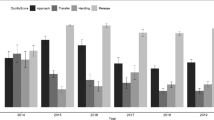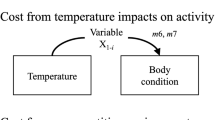Abstract
Female red squirrels (Tamiasciurus hudsonicus) sometimes bequeath their territory to their offspring. Late-breeding females are more likely to leave than are early-breeding females. Early-breeding females tend to lose weight during reproduction while late-breeding females do not. Early-born juveniles are more successful at winning territories than are those born late. I use dynamic programming to investigate the trade-offs involved in territorial bequeathal from the female's perspective as a function of breeding date, litter size and female body condition. The model predicts that two classes of females are more likely to bequeath: those in good condition early in the season, and those in poor condition at the season's end. Only versions of the model incorporating a function improving the female's ability to win a territory over the season mimicked the pattern of bequeathal observed in the field. A seasonal effect is likely an important factor in driving the pattern of strategies observed.
Similar content being viewed by others

Literature
Boyce, C. C. K. and J. L. Boyce 1988. Population biology ofMicrotus arvalis II. Natal and breeding dispersal of females.J. Anim. Ecol. 57, 723–736.
Cockburn, A., R. W. Braithwaite and A. K. Lee 1981. The response of the heath rat,Pseudomys shortridgei, to pyric succession: a temporally dynamic life-history strategy.J. Anim. Ecol. 50, 649–666.
Harris, M. A. and J. O. Murie 1984. Inheritance of nest sites in female Columbian ground squirrels.Behav. Ecol. Sociobiol. 15, 97–102.
Howard, P. C. 1986. Spatial organisation of common reedbuck with special reference to the role of juvenile dispersal in population regulation.Afr. J. Ecol. 24, 155–171.
Kemp, G. A. and L. B. Keith 1970. Dynamics and regulation of red squirrel (Tamiasciurus hudsonicus) populations.Ecology 51, 763–779.
MacFarland Symington, M. 1987. Sex ratio and maternal rank in wild spider monkeys: when daughters disperse.Behav. Ecol. Sociobiol. 20, 421–425.
Mangel, M. and C. W. Clark 1988.Dynamic Modeling in Behavioral Ecology. Princeton: Princeton University Press.
Montgomery, G. G. and M. E. Sunquist 1978. Habitat selection and use by two-toed and three-toed sloths. InThe Ecology of Arboreal Folivores, G. G. Montgomery (Ed.), pp. 329–359. Washington, DC: Smithsonian Institution Press.
Parker, G. A. 1984. Evolutionarily stable strategies. InBehavioural Ecology, J. R. Krebs and N. B. Davies (Eds), pp. 30–61. Massachusetts: Sinauer.
Price, K. 1990. Territorial bequeathal by red squirrel (Tamiasciurus hudsonicus) mothers in the northern boreal forest. MSc thesis, Simon Fraser University, Burnaby, BC.
Price, K., K. Broughton, S. Boutin and A. R. E. Sinclair 1986. Territory size and ownership in red squirrels: response to removal.Can. J. Zool. 64, 1144–1147.
Smith, A. T. and B. L. Ivins 1983. Colonization in a pika population: dispersal vs philopatry.Behav. Ecol. Sociobiol. 13, 37–47.
Woolfenden, G. E. and J. W. Fitzpatrick 1978. The inheritance of territory in group-breeding birds.BioScience 28, 104–108.
Author information
Authors and Affiliations
Rights and permissions
About this article
Cite this article
Price, K. Territorial bequeathal by red squirrel mothers: A dynamic model. Bltn Mathcal Biology 54, 335–354 (1992). https://doi.org/10.1007/BF02464837
Received:
Revised:
Issue Date:
DOI: https://doi.org/10.1007/BF02464837



